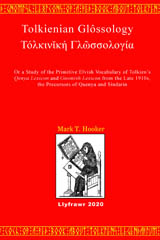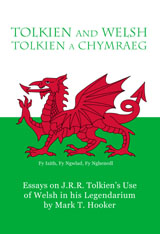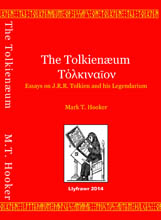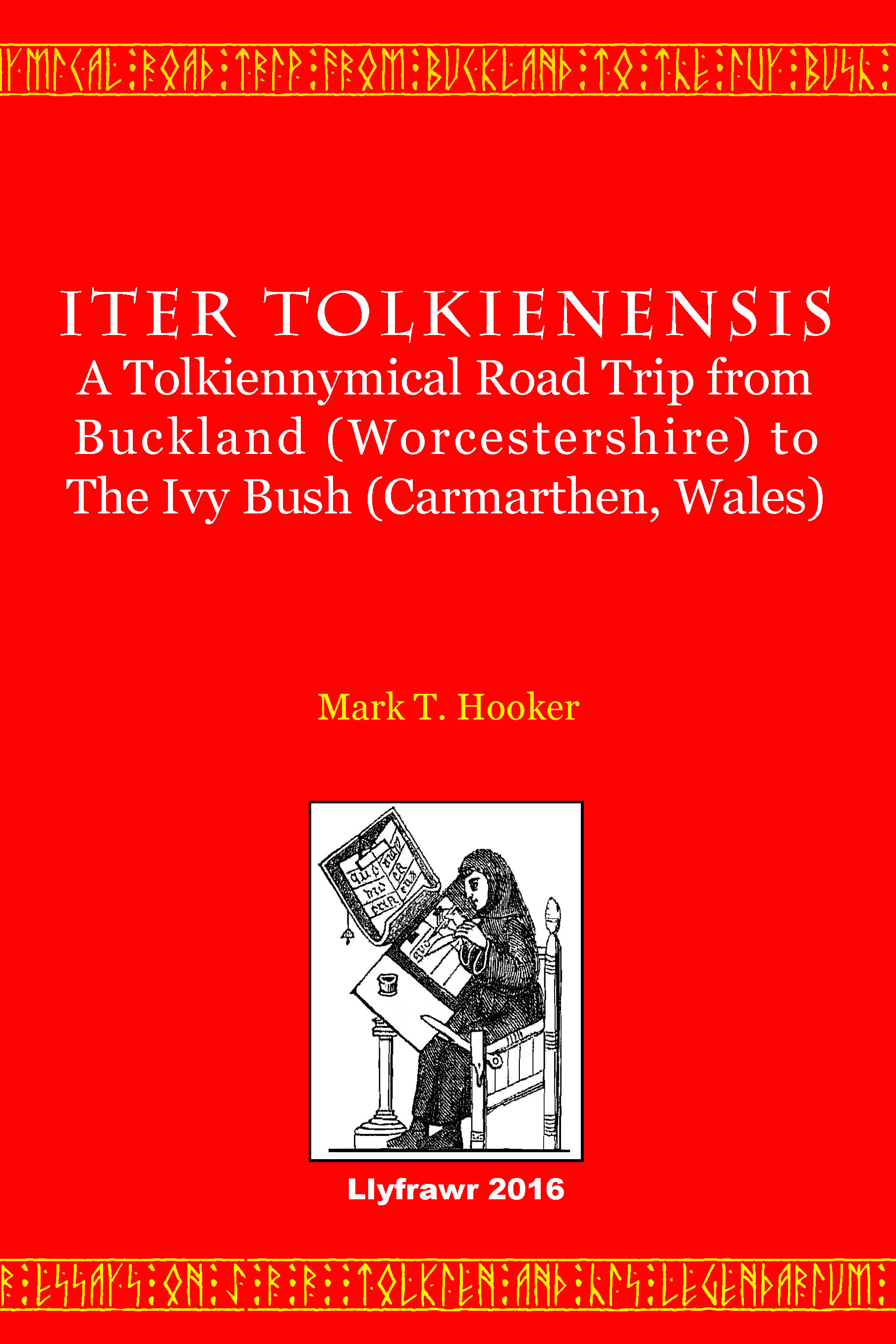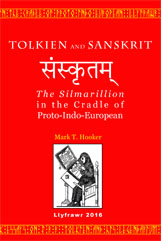|
Also by this author: | From the ForewordTolkienian Glossology examines the linguistic and cultural materials in the Gnomish and Qenya Lexicons that represent Tolkien’s earliest efforts to document the languages that he created for Middle-earth. The materials in the Gnomish and Qenya Lexicons are commonly called primitive Elvish, in contrast to the mature Elvish represented by The Etymologies, where the names of these languages have become Quenya and Noldorin. Not all the lexical materials contained in the Lexicons survived to become a part of mature Elvish. The materials of the Lexicons date to the second half of the 1910s, while the materials in The Etymologies date to the second half of the 1930s. The words and names attested in the Lexicons are the first ‘stones’ that Tolkien created for the foundation of his secondary world, and the patterns observable in the organization of his creative process reflect the patterns inherent in the multi-lingual linguistic baggage (leaf mould of his mind) that Tolkien carried around with him. (L.409) The Qenya and Gnomish Lexicons are fertile hunting grounds for examples of Elvish words with first-world cognates, because this early stage of his language creation is more like a series of notes for forms that would be fun to develop than like a lexicon developed from a corpus of historical texts. In this primitive Elvish stage, the relationship between Elvish and first-world forms is easier to see than in mature Elvish. The ease of seeing the relationships between Elvish words and their first-world ‘cognates’ also makes it easy to recognize the techniques that Tolkien used to make his invented words seem more Elvish and less first-worldish. Tolkien explained that the process behind the creation of Middle-earth was an idiosyncratic enterprise undertaken to satisfy his own private linguistic taste. He was, therefore, not surprised that most analyses of his work went awry because “linguistic invention” is a “comparatively rare” art form, and most analysts have little understanding “of how a philologist would go about it.” Their analyses “appear to be unauthentic embroideries on my work,” said Tolkien, “throwing light only on the state of mind of [their] contrivers, not on me or on my actual intention and procedure.” (L.380) Many early commentators on Tolkien’s language creations adopted the technique of looking for words that are spelled the same in Elvish and some other language, without considering what the Elvish words were supposed to mean. The application of this technique is a fool’s errand not only in Middle-earth, but also in the field of first-world philology. The German word Gift looks like English, but in German das Gift means poison, not a present for someone’s birthday. To English speakers, the Dutch word slim seems to indicate someone who is not overweight, but slim in Dutch means smart. While one might want to put a piece of what is identified by the English word pie (pastry) in one’s mouth, that would not be the case for the Spanish word pie (foot). These are mere chance resemblances, not linguistic relationships—which require both the form and the sense to match. This study applies the techniques of comparative and historical linguistics, which require that both the shape of the word (within the bounds of the commonly accepted laws of systematic sound change) and its sense are the same, hence the title of the study: Glôssology, the study of Tolkien’s lexical translations (glosses) of the Elvish words in the Lexicons. In other words, while non-linguists may see no relationships between the German Tür, the Dutch Deur, and the English door, they all mean the same thing (an entry portal), and, despite the sound (spelling) changes that make them appear different, they are all related to the same parent word. Sound changes like these were part of Tolkien’s academic bread and butter. What makes this book different from other books about Tolkien is that its author is a linguist who shares Tolkien’s appreciation of the histories of words and names, and who plays at the same kind of linguistic invention himself. It is a linguistic perspective that begins with a glossed entry in the Qenya or Gnomish Lexicon, and looks for its story in the real world with which Tolkien would have been familiar.
|
Tolkien’s creative linguistics obviously did not take place in a vacuum, but drew on elements found in the ‘leaf mould’ (the linguistic baggage) of his mind. (L.409) The Lexicons represent Tolkien’s first concrete steps to create a documented language that mirrored the sensibilities and concerns of his Elvish-self in the “New World” of Middle-earth. Tolkien, however, was not able to leave all his “Old World” conceptual and linguistic baggage behind. The parts that he took with him are reflected in the glimpses of continuity with the linguistic leaves that had fallen from the ‘trees’ of the languages that he had been familiar with before Elvish. This study is a look at the linguistic baggage that Tolkien took with him to Middle-earth.
Studies looking into the first-world sources of Tolkien’s Elvish vocabulary are often dismissed because of a comment that Tolkien made in a letter (L.380), where he said: “It must be emphasized that this process of invention was/is a private enterprise undertaken to give pleasure to myself by giving expression to my personal linguistic ‘aesthetic’ or taste and its fluctuations. … The ‘source’, if any, provided solely the sound-sequence (or suggestions for its stimulus) and its purport in the source is totally irrelevant except in case of Eärendil.”
Tolkien’s statement, however, has repeatedly been shown not to be entirely correct. In addition to Eärendil, there are a large number of other Tolkiennyms based on first-world words the original ‘purport’ of which is relevant to the story in which the word/name is a part.
While J.R.R. Tolkien admits that, though he was not aware of ‘borrowing’ from first-world languages when he created words for the languages of Middle-earth, he concludes that “it is probable, but by no means certain, that the names were nonetheless ‘echoes’ [of languages known to him].” One of the invented words he is talking about in this letter is “nazg: the word for ‘ring’ in the Black Speech. It was, he says, “devised to be a vocable as distinct in style and phonetic content from words of the same meaning in Elvish, or in other real languages that are most familiar: English, Latin, Greek, etc.” Tolkien considers it “remarkable that nasc is the word for ‘ring’ in Gaelic (Irish: in Scottish usually written nasg),” and that it “also fits well in meaning, since it also means, and prob. originally meant, a bond, and can be used for an ‘obligation’. Nonetheless I only became aware, or again aware, of its existence recently in looking for something in a Gaelic dictionary. … It is thus probable that nazg is actually derived from it, and this short, hard and clear vocable, sticking out from what seems to me (an unloving alien) a mushy language, became lodged in some corner of my linguistic memory.” (L.384-385)
In Christopher’s discussion of the name Incánus, which was considered to possibly be “a Quenya name devised for [Gandalf] which later became obsolete, and was remembered only by the learned,” Christopher notes that his “father referred to the Latin word incánus (grey-haired) in such a way as to suggest that this was the actual origin of this name.” If this were true, says Christopher, it would be “very surprising.” J.R.R. Tolkien himself “remarked that the coincidence in form of the Quenya name and the Latin word must be regarded as an ‘accident’, in the same way that Sindarin Orthanc (Forked Height) happens to coincide with the Anglo-Saxon word orþanc (cunning device), which is the translation of the actual name in the language of the Rohirrim.” (UT:400)
In a manuscript dated March 1967, Tolkien summarizes the information about the Elvish word miruvóre (nectar, drink of gods, drink of the Valar, QL.61), and explains that: “Its actual origin as an ‘invention’ goes back to at least 1915, its real source being Gothic *midu (= Gmc. među) + woþeis, then supposed to have been developed so: miđuwōþi > miđuwōdi > miřuwōři > miruvóre.” (QL.xi)
So, while it may have been Tolkien’s oft-repeated, ‘official’ position that it was ‘very surprising’ and ‘accidental’ for Elvish words to coincide with first-world forms as a result of the first-world form having ‘become lodged in some corner of his linguistic memory,’ his statement about the origin of miruvóre manifestly contradicts that position. This implies that Tolkien’s idea of ‘accidental’ or ‘surprising’ unconscious borrowing should not be taken too categorically.
Tolkien concedes that: “Nonetheless one’s mind is, of course, stored with a ‘leaf-mould’ of memories (submerged) of names, and these rise up to the surface at times, and may provide with modification the bases of ‘invented’ names.” (L.409) The goal of this study is an examination of the leaf mould of Tolkien’s mind as reflected in the Qenya and Gnomish Lexicons, and a look at how those leaves were modified.
In a letter, Tolkien said that ‘philology’ is:
“I think a primary ‘fact’ about my work, that it is all of a piece, and fundamentally linguistic in inspiration. … The invention of languages is the foundation. The ‘stones’ were made rather to provide a world for the languages than the reverse. To me a name comes first and the story follows. … But there is a great deal of linguistic matter (other than actually ‘elvish’ names and words) included or mythologically expressed in the book. It is to me, anyway, largely an essay in ‘linguistic aesthetic’, as I sometimes say to people who ask me ‘what is it all about?’” (L.219)
There are numerous Elvish words that recall Old English, Latin, German, Welsh, Irish, Sanskrit, Russian, and Finnish. The discussions of the materials of the Gnomish and Qenya Lexicons are intended to give some idea of the scope of the ‘leaf mould’ of Tolkien’s mind.
Tolkien’s language conceit posits that modern first-world words were derived from older Elvish forms. In other words, Middle-earth is the predecessor of our own reality, occupying the same space, but at a different time (L.220), and that ‘modern’ first-world languages and stories derive from the culture that Tolkien is describing. Tolkien remarked in a letter that: “always I had the sense of recording what was already ‘there’, somewhere: not of ‘inventing’.” (L.145, see also L.212.n)
Tolkien’s process of linguistic creation was not just the invention of random items of vocabulary. Tolkien’s nomenclature had to fit into the world he had created. In other words, he constructed a historical linguistic conceit that ‘rediscovered’ the Elvish origins of words found in modern languages that were ‘previously’ assumed to have developed from Proto-Indo-European.
He did this by applying the tools of his trade as a comparative philologist; introducing variations that were consistent with the historical process of language dispersal and development of which his academic training in language history, etymology, and sound change made him aware. The study of the materials from the Lexicons is particularly interesting, because seeing the similarity of mature Elvish words to their first-world ‘cognates’ requires a great deal more linguistic acumen than it take to identify the similarities with the primitive Elvish words from the Lexicons.
In other words, Elvish words have first-world ‘cognates’ that are ‘descendants’ of older Elvish forms by design. To support this view of language divergence, Tolkien has Elvish ‘cognates’ sprinkled around various points on the Proto-Indo-European (PIE) timeline to make his point. ‘Cognates’ for Elvish words are found in Rig Vedic Sanskrit (mid-to-late second millennium B.C.), Ancient Greek (9th century B.C.), Classical Latin (1st century B.C.), Gothic (4th century A.D.), Brittonic (5th century A.D.), and Russian (12th century A.D.).
The rich and, for many a ‘non-linguist,’ unexpected rewards of the study of Tolkiennyms are an increased appreciation of how widely read Tolkien was, and an insight into the workshop of a creative linguist who was not just inventing languages and stories in those languages, but ‘rediscovering’ the history of languages and their myths through the lens of Elvo-Indo-European. This is one of the things that makes Middle-earth feel like historical fact, rather than like fiction. Tolkien is able to create a credible linguistic history, because of the vast knowledge of historical linguistics that his academic career required of him.
At the lowest level of complexity are loanwords, what Christopher calls ‘historical punning’ (Sahóra ⟨the South⟩, hôr ⟨old⟩, here ⟨rule⟩, rûm ⟨secret⟩). These are the Elvish words that are most easily recognizable as first-world lexemes. Additions to Christopher’s list, for example, include the Dutch lommer (shade, shadow ⟨especially of leaves⟩) which became the Qenya lōmin (shade, shadow); the Sanskrit kāra, an agent suffix that means a maker, or doer, which became the Qenya root KARA– (do, make); and the Old Norse fifrildi (butterfly), which became the Qenya *fufril (a moth).
A further level of obfuscation is provided by the drow-s, Elvish words that are easily recognizable as first-world lexemes, if they are spelled backwards. Examples of this type of formation are the Russian мир (mir, peace) that became the Gnomish rim (peace) when spelled backward; the German word Gelb (yellow) that became the Gnomish bleg (a flame) when spelled backward; and the Ancient Greek ριγος (rhîgos: frost, cold, chilliness), cognate with the English rigor, and the derivative verb ριγέω (rhigéō, to shudder from cold or fear) that became the Elvish root GIR– (quiver, shudder) when spelled backward. The invented language Nevbosh, one of the earliest of the linguistic creations mentioned in Tolkien’s biography contained the drow woc, which meant cow, as in a female of the species Bos taurus.
The next level of complexity are calques, Elvish words that replicate the sense of first-world words through a syllable-by-syllable translation. Examples of Elvish words of this type are Erinti (Little One, his favorite name for his wife) and grothorf (literally: ground apple: compare the Dutch aardappel = potato). Tolkien calqued his surname into Gothic as Dwalakoneis (L.357), and did the same thing to create the names of the Seven Rivers of Ossiriand from the Sanskrit names of the Sapta Sindhavah (Seven Rivers) from the Rig Veda.
An even greater degree of mystification is provided by sound shifts that camouflage first-world words, making it harder to recognize them. The German word Zelt (tent), for example, became the Elvish telt (roof) via a predictable sound (spelling) change; the German word Säule (column, pillar) became the Qenya taule (pillar) through a similar process; and the Welsh sawr (odor) went through two sound changes (S > θ > F) to become the Quenya Sauron and the Gnomish Thû (stench) with a cognate of *fau (impersonal: it smells, gives off a smell), via an English dialectical process.
Some of the primitive Elvish names in the Lexicons that did not make it through to the mature Elvish of The Etymologies carry suggestions of stories from Tolkien’s personal life. For example the Elvish words for:
- Africa: 1) Andesalke (literally: Long-grass, QL.31), 2) Salkinóre | Salkinōre (literally: Grassland, QL.84); the land of Tolkien’s birth (South Africa).
- Brother Hilary: 1) Amillo (Hilary, one of the happy people), 2) Amillion (February, his month) (QL.30); Hilary Tolkien was born on 17 February 1894.
- Fr. Francis: Faithron (Francis, GL.33); Tolkien’s guardian and an ‘agent of faith’ in Tolkien’s life.
- Christ, the Saviour: faithir (liberator, Saviour, GL.33); and indication of Tolkien’s devout Catholic faith.
- Germany: 1) *kalimban (“Barbary”, Germany), 2) kalimbardi (the Germans) QL.44; based on a Sanskrit word for the ‘root of all evil,’ a word created in the middle of World War I.
- Erinti (Little One), Tolkien’s “favorite name” for his fiancée, soon-to-be wife.
- kiss: 1) cailthi (kiss), 2) the verb cailtha– (to kiss) (GL.24); a reminder that Tolkien was human, and wanted to kiss his beautiful fiancée, soon-to-be wife.
The present discussion of Elvish words with their Elvo-Indo-European cognates is intended to highlight the spectrum of languages of which Tolkien had some knowledge, to document the linguistic techniques he used to convert them into Elvish, and to show how the sense of the first-world cognate and its Elvish ‘original’ were indeed similar, and how the first-world prompt of an Elvish word helps to understand what it means.
In his “Guide to the Names in The Lord of the Rings,” Tolkien cites forms in Middle-English, Old English, Danish, Dutch, French, Middle High German, Old High German, Modern German, Icelandic, Old Norse, Norwegian, and Old Swedish. During his work on the article for the word wasp at the Oxford English Dictionary, notes Carpenter, Tolkien demonstrated his skills as a comparative philologist by citing related forms in Old Saxon, Middle Dutch, Modern Dutch, Old High German, Middle Low German, Middle High German, Modern German, Old Teutonic, primitive pre-Teutonic, Lithuanian, Old Slavonic, Russian, and Latin. (Carpenter 113) In the present study, these languages do the bulk of the heavy lifting in the comparisons of Elvish with first-world forms.
While Tolkien’s original goal may have been to converse with himself in the new idiom of the Elves of Middle-earth, un-noticed like the ‘man behind the curtain’ whom no one is supposed to pay attention to in The Wizard of Oz, his linguistic baggage left a trail to his hiding place. The recognition of the relationship between the appearance and meaning of Elvish and first-world languages is a logical introduction to Tolkien’s linguistic thought process.
Includes maps, B&W illustrations, bibliographic references and index.
Pagination: xl + 266. Trade Paper $14.95.
To learn more about the book, follow the links below.

